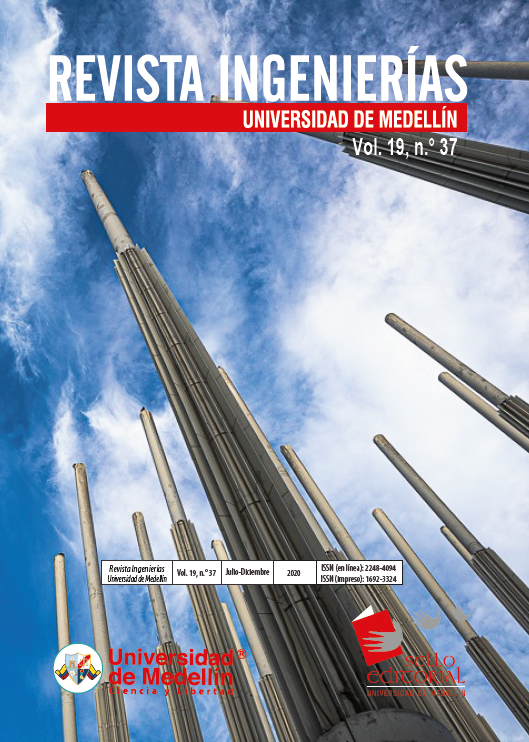Prototipo y método para análisis de cultivos en el espectro visible e infrarrojo desde un vehículo aéreo multirrotor
Contenido principal del artículo
Resumen
La salud de las plantas tiene un impacto directo en la calidad y cantidad de los productos agrícolas. Debido esto, los agricultores deben monitorear las condiciones de los cultivos con frecuencia, pero las herramientas actuales para llevar a cabo esta tarea son complejas e inaccesibles. Frente a esta situación, se propone en este artículo un método para la caracterización de cultivos que permita un monitoreo de las plantas a través fotografías en el espectro visible e infrarrojo adquiridas desde un vehículo aéreo multirrotor, mediante cámaras de bajo costo y herramientas de uso libre para el diseño de un prototipo de rocesamiento de información. La caracterización se realizó mediante la identificación del índice de vegetación de diferencia normalizado (NDVI) en los mosaicos fotográficos de los cultivos. Este índice es capaz de proveer información acerca de la salud de las plantas, por lo cual se calcula y representa en un mapa NDVI en el que se analiza el estado del cultivo. Los valores más altos de NDVI representan a las plantas saludables, y los más bajos a las plantas con problemas, al agua u otros. El método propuesto permite monitorear cultivos de forma temporal y especial, con lo cual se llevaría al productor a tomar medidas que permitan la optimización de recursos.
Detalles del artículo
Citas
[1] A. Samad, and A. Manan, 'Aerial mapping using high resolution digital camera and unmanned aerial vehicle for Geographical Information System', in 2010 6th International Colloquium on Signal Processing and its Applications (CSPA), 2010. DOI: 10.1109/CSPA.2010.5545303.
[2] J. Bendig, K. Yu, H. Aasen, A. Bolten, S. Bennertz, J. Broscheit, M. Gnyp, and G. Bareth, 'Combining UAV-based plant height from crop surface models, visible, and near infrared vegetation indices for biomass monitoring in barley,' International Journal of Applied Earth Observation and Geoinformation, vol. 39, pp. 79-87, 2015. DOI: 10.1016/j.jag.2015.02.012
[3] C. Gonzaga Aguilar, 'Aplicación de índices de vegetación derivados de imágenes satelitales Landsat 7 ETM+ y ASTER para la caracterización de la cobertura vegetal en la zona centro de la provincia de Loja, Ecuador,' Universidad Nacional de La Plata, 2014. [Online]. Available: http://sedici.unlp.edu.ar/bitstream/handle/10915/34487/Documento_completo.pdf?sequence=1.
[4] E. R. Hunt, C. S. Daughtry, S. B. Mirsky, and W. D. Hively, 'Remote sensing with simulated unmanned aircraft imagery for precision agriculture applications,' IEEE Journal of elected Topics in Applied Earth Observations and Remote Sensing, pp. 4566-4571, 2014. DOI: 10.1109/JSTARS.2014.2317876.
[5] W. Wei, Y. Xia, Y.-c. TIAN, X.-j. LIU, N. Jun, W.-x. CAO, and Z. Yan, 'Common spectral bands and optimum vegetation indices for monitoring leaf nitrogen accumulation in rice and wheat,' Journal of Integrative Agriculture, pp. 2001-2012, 2012. DOI: 10.1016/S2095-3119(12)60457-2.
[6] W. Li, Z. Niu, H. Chen, D. Li, M. Wu and W. Zhao, 'Remote estimation of canopy height and aboveground biomass of maize using high-resolution stereo images from a low-cost unmanned aerial vehicle system,' Ecological Indicators, pp. 637-648, 2016. DOI: 10.1016/j.ecolind.2016.03.036.
[7] A. Gitelson, Y. Kaufman, R. Stark, and D. Rundquist, 'Novel algorithms for remote estimation of vegetation fraction,' Remote Sensing of Environment, pp. 76-87, 2002. DOI: 10.1016/S0034-4257(01)00289-9.
[8] Banco Mundial, 'Agricultura y desarrollo-rural,' 2016. [Online]. Available: http://datos. bancomundial.org/tema/agricultura-y-desarrollo-rural?locations=CO.
[9] Banco Mundial, 'Indicadores de desarrollo del mundo,' 2015. [Online]. Available: http://wdi.worldbank.org/table/4.2.
[10] ArcGis, 'Función NDVI,' 2016. [Online]. Available: http://desktop.arcgis.com/es/arcmap/10.3/manage-data/raster-and-images/ndvi-function.htm.
[11] Universidad de Piura, 'Biblioteca Universidad de Piura'. [Online]. Available: http://www.biblioteca.udep.edu.pe/BibVirUDEP/tesis/pdf/1_59_185_24_508.pdf.
[12] V. Dworak, J. Selbeck, K.-H. Dammer, M. Hoffmann, A. A. Zarezadeh, and C. Bobda, 'Strategy for the development of a smart NDVI camera system for outdoor plant detection
and agricultural embedded systems,' Multidisciplinary Digital Publishing Institute, vol. 13, no. 2, pp. 1523-1538, 2013. DOI: 10.3390/s130201523.
[13] B. José, M. Nicolás, C. Danilo and A. Eduardo, 'Multispectral NDVI aerial image system for vegetation analysis by using a consumer camera,' in Electronics and Computing (ROPEC), 2014 IEEE International Autumn Meeting on Power, pp. 1-6, 2014. DOI: 10.1109/ROPEC.2014.7036302.
[14] M. Ghazal, Y. Al Khalil and H. Hajjdiab, 'UAV-based remote sensing for vegetation cover estimation using NDVI imagery and level sets method,' in 2015 IEEE International Symposium on Signal Processing and Information Technology (ISSPIT), pp. 332-337, 2015. DOI: 10.1109/ISSPIT.2015.7394354.
[15] N. R. Rodrigo Andrés, 'Fotografía Aérea,' 2005. [Online]. Available: http://cybertesis.uach. cl/tesis/uach/2005/bmfcin415f/doc/bmfcin415f.pdf.
[16] A. Thomas, 'Aerial Photography,' University of the Western Cape. [Online]. Available: http://www.cdioinstitute.org/papers/Day1/AERIAL%20PHOTOGRAPHY_Abraham_Thomas.pdf.
[17] A. Díaz, and M. A. Cisternas, 'Fotografías Aéreas Aspectos Técnicos'. [Online]. Available: https://wikigeomatica.wikispaces.com/file/view/fotosaereas.pdf.
[18] OpenCV, 'OpenCV Image Matching'. [Online]. Available: http://docs.opencv.org/2.4/doc/tutorials/imgproc/histograms/template_matching/template_matching.html.
[19] V. Andreo, 'Remote Sensing and Geographic Information Systems in Precision Farming,'2013. [Online]. Available: http://aulavirtual.ig.conae.gov.ar/moodle/pluginfile.php/513/mod_page/content/96/seminario_andreo_2013.pdf.
[20] Humboldt State University, 'Spectral Reflectance'. [Online]. Available: http://gsp.humboldt.edu/OLM/Courses/GSP_216_Online/lesson2-1/reflectance.html.
[21] University of Oldenburg, 'Spectral Reflectance Properties'. [Online]. Available: http://www.seos-project.eu/modules/remotesensing/remotesensing-c01-p05.html.
[22] L. C. Velásquez, J. Argueta and K. Mazariegos, 'Implementation of a low cost aerial vehicle for crop analysis in emerging countries,' IEEE Journal, pp. 21-27, 2016. https://doi.org/10.1109/GHTC.2016.7857255
[23] B. Ortiz, J. Shaw, and J. Fulton, 'Basics of crop sensing,' Alabama Cooperative Extension System, pp. 1-3, 2011.
[24] A. A. Gitelson, Y. Gritz, and M. N. Merzlyak, 'Relationships between leaf chlorophyll content and spectral reflectance and algorithms for non-destructive chlorophyll assessment in higher plant leaves,' Journal of Plant Physiology, vol. 160, no. 3, pp. 271-282, 2003. DOI:10.1078/0176-1617-00887.
[25] D. M. Gates, H. J. Keegan, J. C. Schleter, and V. R. Weidner, 'Spectral properties of plants,' Applied Optics, vol. 4, no. 1, pp. 11-20, 1965. DOI: 10.1364/AO.4.000011.
[26] Municipio de Timbío, 'Información General Timbío'. [Online]. Available: http://timbio-cauca.gov.co/informacion_general.shtml.
[27] M. Research, 'Image Composite Editor,' 2015. [Online]. Available: https://www.microsoft.com/en-us/research/product/computational-photography-applications/image-composite-editor/.





